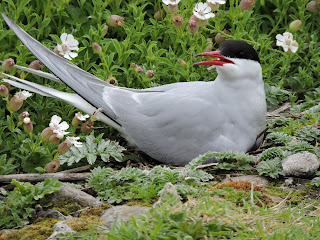Continuing
my enjoyment of islands in general and my nearest ones, those in the
Firth of Forth, in particular, I took a trip out to the Isle of May. (Blogs 6/9/2015, 1/5/2017)
The
island is so far out in the mouth of the firth that it is part of
Fife. The name probably means the Island of Seabirds - ma'a or maw
is Scots for a gull. The word is Scandinavian in origin.
It
certainly lived up to its eponym. Terns, puffins, guillemots,
razorbills, shags, eider duck, fulmars kittiwakes and herring gulls
all nesting in their own environmental niche. The black-back gulls
patrolled the island looking for prey. Woe betide any inattentive
parent or nestling.
 |
| Arctic Tern |
Terns
are very aggressive when nesting. We were advised to hold something
up as they attack the highest point of any intruder. Holding my
sun-hat on an extended finger was a mistake as tern beaks are very
sharp and my cloth- covered finger became the target for a pin-point
assault. With their staccato machine-gun calls, it was like being
strafed by a squadron of miniature fighter planes.
They
also have another weapon. They can bomb you with excrement which is
no fun if you are already hatless !
I
suppose if you have flown halfway in a 50,000 mile round trip from
the Antarctic to Scotland and back, you are entitled to get a bit
grumpy with folk gawping at you.
The
puffins are altogether more amiable and seem to enjoy posing for
visitors with cameras. The Isle of May has the biggest single
colony in the UK. They could be seen waddling about near their
burrows, their beaks stuffed with small fish. They are the most
lovable of birds with their massive parrot beaks and their sad-eyed
clown faces.
 |
| Razorbill, Shag and Eider Duck |
The
island has been a place of sanctity since the seventh century when St
Ethernan (Adrian), an obscure Irish bishop or possibly a Scot
trained in Ireland, died there in 669 A.D.
He
is often conflated with Adrian also called St Adrian, the abbot of
the monastery killed by Vikings in 875 A.D.
 |
| St Adrian's Priory |
The
Benedictine monastery, endowed by David I in the 13th century, became
a place of pilgrimage along the route of holy sites from St Andrews
to Holy Island. Many of the topographical features have an
ecclesiastical ring to their names - Alterstanes, Bishops Cove,
Pilgrim's Haven, rocks called The Angel and The Pilgrim.
 |
| The Angel and The Pilgrim |
Holy men expelled the demons and wild beasts from the island of
the May and there made a place of prayer*
The
abbey was built on the site of a massive prehistoric burial mound
dating as far back as the Bronze Age which might explain the "demons"
but what wild beasts could there be on the island? Seals perhaps?
 |
| A carpet of sea campion |
The
oldest lighthouse in Britain, a coal burning flame called the Beacon was built on the
island in 1635 and there is a light-house there to this day though
now completely automatic.
 |
| The Beacon now undergoing conservation |
Monks
and pilgrims, royalty and commoners, fishermen and light-house
keepers, soldiers and sailors have all lived on the island over the
centuries from as far back as the Bronze Age and, in all that time,
the puffins and the terns have returned to breed every year. It is
somehow satisfying that apart from a few nosey folk like me, they
have it all to themselves again.
The return trip included an approach to the Bass Rock, the largest breeding colony of the Northern Gannet in the world - 150,000 birds crammed on to its bare slopes, a truly amazing sight.
 |
| Leaving the Bass and the gannets |
*
Aberdeen Breviary 1510








No comments:
Post a Comment